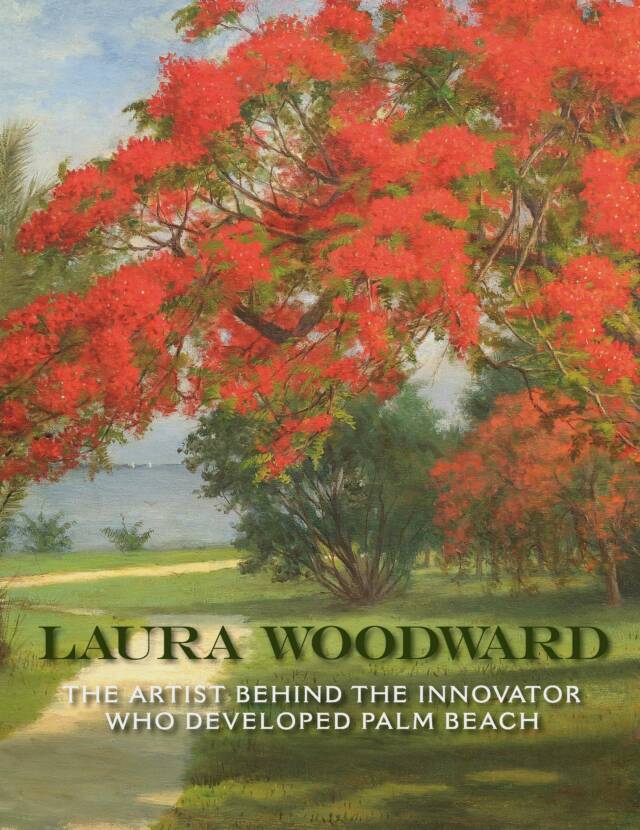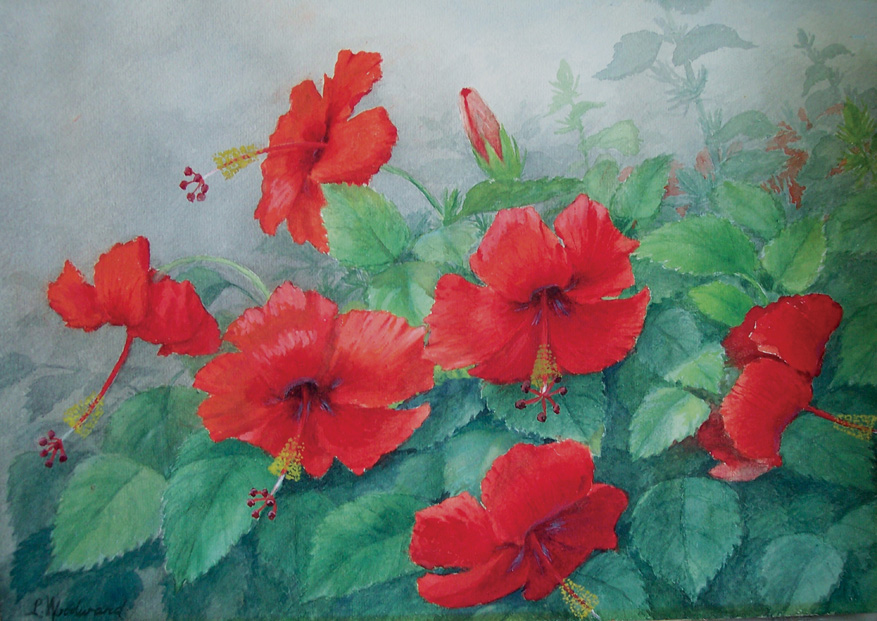Critically Acclaimed and a Palm Beach Best Seller
More Editorial Reviews:
Magnolia, Publication of the Southern Garden History Society, Vol. XXIV, No. 1, Winter 2011
Book Review
Laura Woodward: The Artist Behind the Innovator Who Developed Palm Beach, by Deborah C. Pollack, Blue Heron Press; hardcover, 264 pp, 2009; ISBN-13:9780977839919; list price $39.99.
In about 1889 Laura Woodward (1834-1926), a New York-based artist then wintering in St. Augustine, decided to visit a small south Florida community. Having spent several rewarding seasons painting the natural landscape and cultivated grounds of the north Florida resort, and enjoying the acclaim of guest sat the fashionable Ponce de Leon Hotel and the patronage of its owner Henry Morrison Flagler, she was lured by descriptions of “the wonderful scenery, the beautiful flowers, and above all the cocoanut trees” of an eden bordered by the Atlantic Ocean on the east and Lake Worth on the west. The “hard trip of several days” over 235 miles involved careful planning: she traveled by two short railroad lines as far as Titusville and then on a riverboat to Jupiter, thence by a third train to Juno, Florida, and last by a mail boat to the village and the shaded veranda of the Cocoanut Grove House. Some thirty years later Laura Woodward recalled the experience. “When I arrived I found the semi-tropical foliage of which I had dreamed. It was the most beautiful place I had ever seen.” Laura Woodward returned to her newly-found paradise the following year, and by 1893 she became a permanent, pioneering member of the winter colony at the place, which became Palm Beach. That same year Henry Morrison Flagler began construction of the Royal Poinciana Hotel, a vast six-story Colonial Revival-style frame hotel overlooking Lake Worth, which was completed in 1894. In 1895 he began building a second, smaller, ocean-side hotel, the Palm Beach Inn, which would be later enlarged and renamed The Breakers. In 1896 Mr. Flagler welcomed guests to both hotels on the first run of his newly-completed Florida East Coast railroad linking Palm Beach and the other Florida resorts with the Northeast. In Laura Woodward: The Artist Behind the Innovator Who Developed Palm Beach, Deborah C. Pollack recounts the long career Laura Woodward enjoyed as a painter of Florida scenery, its fabled cocoanut palms, and Royal Poinciana flowers, and the important role she played as an artist in promoting and popularizing Florida. Doing so she also gives voice to the crucial association Miss Woodward held with Henry Morrison Flagler (1830-1913). As the chief developer of Florida in the late-nineteenth century, Mr. Flagler appreciated the appeal of artists such as Laura Woodward and Martin Johnson Heade, among others, who became influential figures in the winter colony centered on Flagler’s Ponce de Leon Hotel in St. Augustine. Beginning in the 1880s Henry Morrison Flagler’s support was personal and financial. Artists had rooms and studios in the hotel, showed their works in exhibitions on its premises, and gained prominence as Florida’s winter colonies grew and Mr. Flagler, Henry Plant, and other capitalist/developers prospered. Laura Woodward came first to St. Augustine in the1880s as a winter resident and remained there until 1893, when she decamped for Palm Beach. In this new resort she continued to enjoy the patronage of the now legendary Florida developer up to his death in 1913. Today many of her paintings hang in Whitehall, his winter mansion completed in 1902 and now the Henry Morrison Flagler Museum. Laura Woodward remained a resident of Palm Beach into 1926 when she relocated to St. Cloud, Florida. There she celebrated her 92nd birthday on March 18th and died on May 9th.In the pages of Laura Woodward Deborah C. Pollock focuses her study on the artist and her years in Florida. This well-researched narrative, supported by endnotes, comprises four of the book’s five chapters. It also represents the last thirty-seven years of Laura Woodward’s long life. The first decades of the artist’s life are compacted in an opening chapter that begins with Miss Woodward’s birth in Mount Hope, Orange County, New York, in 1834. The story moves quickly into the1870s, when Laura Woodward appears as a member of the Hudson River School and one of a small, emerging group of female artists gaining presence in New York. Her evocative landscapes painted in Vermont, New Hampshire, New York, New Jersey, Pennsylvania, and on the coasts of Massachusetts and Maine were exhibited at the National Academy of Design from 1872 to 1891, the Centennial Exposition in Philadelphia, the Brooklyn Art Association, the American Art Galleries, and at other venues throughout the 1870s and 1880s. Her works, including “Yellow-Birds and Cardinal Flowers,” were sometimes reproduced as chromolithographs by Louis Prang and Company and enjoyed wide circulation. She also sold her works through commercial galleries and on occasionan saw paintings sold at art auctions in New York. Laura Woodward was accomplished, successful, and experienced when she came to Florida and embarked on a second career as a painter of its landscape, palms, plants, and flowers. Laura Woodward: The Artist Behind the Innovator Who Developed Palm Beach provides an excellent introduction to the Society’s planned 2012 meeting at the Edison and Ford Estates at Fort Myers.
Aristos, February 2011
Notes and Comments
by Louis Torres
Laura Woodward (1834-1926): Intrepid Landscape Painter
In Laura Woodward: The Artist Behind the Innovator Who Developed Palm Beach, Deborah Pollack introduces readers to the inspiring life and work of this accomplished but little-known American painter. A member of the Hudson River and White Mountain schools of painting, Woodward later "braved [Florida's] alligator, panther and bear-infused jungles" to depict the natural beauty of the yet-undeveloped state in the late nineteenth century. What can be gleaned of the book online suggests that it should be of interest to anyone who loves landscape painting and cares about its history in nineteenth-century America. (Two paintings by Woodward: St. Augustine Skyline [Fla.] and Gloucester Harbor [Mass.].)

